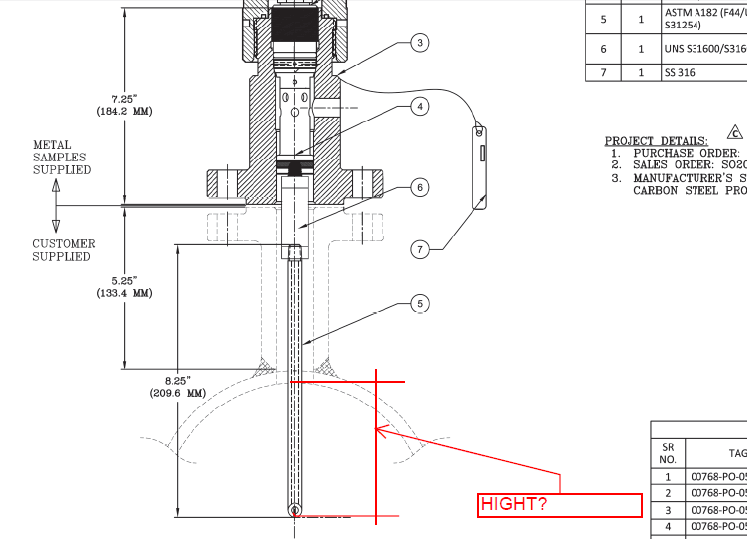Navigation
Install the app
How to install the app on iOS
Follow along with the video below to see how to install our site as a web app on your home screen.
Note: This feature may not be available in some browsers.
More options
Style variation
-
Congratulations MintJulep on being selected by the Eng-Tips community for having the most helpful posts in the forums last week. Way to Go!
You are using an out of date browser. It may not display this or other websites correctly.
You should upgrade or use an alternative browser.
You should upgrade or use an alternative browser.
INJECTION QUILL PROBE DIMENSION 1
- Thread starter xnabrar
- Start date
- Status
- Not open for further replies.
-
1
- #2
LittleInch
Petroleum
You need to get the vendor to certify this for vortex vibrations for the fluid and max velocity / flow rate you will see.
Otherwise somewhere between 0.3D and 0.5 D in my experience.
0.5 if you can, but often it gets limited by the vortex and force / bending moment on the top weld or screw in of the quill.
Quite often people come back a few months / years later when it's not mixing so well and find the quill has vanished!
Remember - More details = better answers
Also: If you get a response it's polite to respond to it.
Otherwise somewhere between 0.3D and 0.5 D in my experience.
0.5 if you can, but often it gets limited by the vortex and force / bending moment on the top weld or screw in of the quill.
Quite often people come back a few months / years later when it's not mixing so well and find the quill has vanished!
Remember - More details = better answers
Also: If you get a response it's polite to respond to it.
- Thread starter
- #4
@0707 - you wouldn't generally have a spray nozzle going counter current in a gas pipeline. A chamfered quill in a liquid line, yes. As for the quill insertion length, Google "wake frequency calculation"
Steve Jones
Corrosion Management Consultant
All answers are personal opinions only and are in no way connected with any employer.
Steve Jones
Corrosion Management Consultant
All answers are personal opinions only and are in no way connected with any employer.
LittleInch
Petroleum
LittleInch said:Quite often people come back a few months / years later when it's not mixing so well and find the quill has vanished!
Exactly!
Remember - More details = better answers
Also: If you get a response it's polite to respond to it.
These quills can be fabricated from a number of different materials. If the correct material is selected for the application, the device is not going to disappear.
P = PVC
C = CPVC
H = Alloy C276
S = 316SS
A = Alloy20
T = Titanium Gr.2
P = PVC
C = CPVC
H = Alloy C276
S = 316SS
A = Alloy20
T = Titanium Gr.2
LittleInch
Petroleum
No, I was just agreeing with myself and 0707....
Remember - More details = better answers
Also: If you get a response it's polite to respond to it.
Remember - More details = better answers
Also: If you get a response it's polite to respond to it.
EdStainless
Materials
With quills both erosion and fatigue (both enhanced by corrosion) are issues.
Given the option I would always select a Ni alloy (625 or C276) fro strength and corrosion resistance.
Ti is very problematic because of fatigue (low modulus=more vibration and low fatigue strength), Ti quills need to be larger diameter.
There are a lot of applications where SS will work fine, but double check that it is compatible with the product being injected.
My favorite story is about a personal care products firm making shampoo. There is an additive that is only about 0.2% in the finished product. As a concentrate it will devour 316L SS. They learned the hard way, lost the quill and then wiped out about 40' of pipe as it ran along the wall before mixing.
= = = = = = = = = = = = = = = = = = = =
P.E. Metallurgy, consulting work welcomed
Given the option I would always select a Ni alloy (625 or C276) fro strength and corrosion resistance.
Ti is very problematic because of fatigue (low modulus=more vibration and low fatigue strength), Ti quills need to be larger diameter.
There are a lot of applications where SS will work fine, but double check that it is compatible with the product being injected.
My favorite story is about a personal care products firm making shampoo. There is an additive that is only about 0.2% in the finished product. As a concentrate it will devour 316L SS. They learned the hard way, lost the quill and then wiped out about 40' of pipe as it ran along the wall before mixing.
= = = = = = = = = = = = = = = = = = = =
P.E. Metallurgy, consulting work welcomed
- Status
- Not open for further replies.
Similar threads
- Replies
- 18
- Views
- 1K
- Locked
- Question
- Replies
- 0
- Views
- 721
- Locked
- Question
- Replies
- 2
- Views
- 404
- Replies
- 6
- Views
- 588
- Locked
- Question
- Replies
- 8
- Views
- 501


